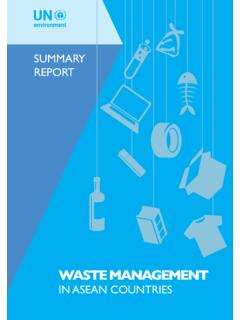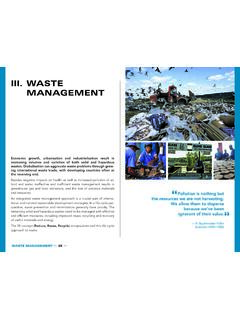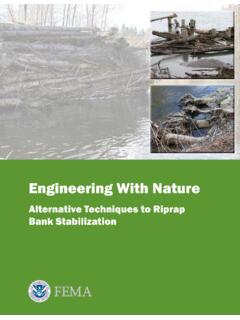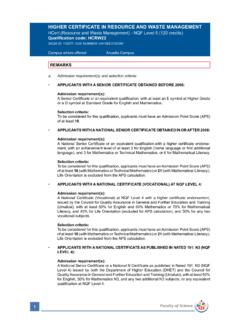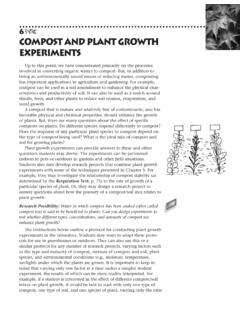Transcription of Waste Management in Japan ~Rules and Figures~
1 Waste Management in Japan ~Rules and Figures~ November, 2018 Japan Industrial Waste Information Center of the development of the legal and regulatory framework relating to Waste Management in Japan 1 Title of the law (year of enactment) Key features Background Waste Sanitation Law (1900) Main target: night soil Individual municipalities made responsible for the Waste disposal Beginning of rapid urbanization Public Cleansing Act (1954) Target changed from night soil to solid Waste (hereafter referred to as Waste ). Clearly stipulated that the purpose of the law was to promote the speedy removal of Waste from places where people are engaged in their daily life In principle, Waste should be incinerated Increase in the amount of Waste being generated as a result of the economic revival after the end of World War II Waste Management and Public Cleansing Law (1970) Clarification of the responsibility for Waste disposal Industrial Waste : Waste generator Municipal Waste .
2 Municipality Setting criteria for Waste disposal Increase in the amount of, and change in of the quality of, the Waste derived from business activities, as a result of Japan s high economic growth Responding to environmental conservation measures relating to Waste disposal Amendment to Waste Management and Public Cleansing Law (1976) Title of the law (year of enactment) Key features Background Amendment to Waste Management and Public Cleansing Law (1991, 97) Promotion of the reduction of Waste discharge, and also sorting and recycling Promotion of the construction of safe and appropriate facilities, through public sector involvement Thorough implementation of the responsibility for Waste disposal environmentally conscious and appropriate Waste treatment Growing concern within society regarding the emission of Dioxins after incineration Pressing situation regarding residual volume of the final disposal sites Basic Environment Law (1993) Containers and Packaging Recycling Law (1995) Home Electric Appliances Recycling Law (1998) Dioxins Control Law (1999) Basic Law for Establishing a sound Material-Cycle Society (2000) Promotion of the 3R(Reduce, Reuse and Recycle)
3 Concept to support the establishment of a sound material-cycle society Strengthening the industrial Waste disposal measures Strengthening the anti illegal dumping measures Growing awareness of the need for effective utilization of resources, and of the global scale of environmental pollution Further deterioration in the situation in regard to the securing of final disposal sites Construction Material Recycling Law (2000) Food Waste Recycling Law (2000) End-of-Life Vehicles Recycling Law (2000) Amendment to Waste Management and Public Cleansing Law (2003-06, 10, 15, 17) Small Home Electric Appliances Recycling Law (2013) 2 Waste Management Law Law for the Promotion of Effective Use of Resources Containers and Packaging Recycling Law The Basic Environment Law Basic Environment Plan Promotion of 3Rs Proper treatment of Waste Regulations targeting individual articles Air conditioners, refrigerators, freezers, TVs, washing machines, drying machines Green Purchasing Law Initiative to promote the procurement of recycled items)
4 Enforced in April 2001 Timber, concrete, asphalt Food residues Vehicles Home Electric Appliances Recycling Law Construction Materials Recycling Law End-of-Life Vehicles Recycling Law Ensuring material cycle in society Reducing consumption of natural resources Lowering environmental load Basic Law for Establishing a sound Material-Cycle Society Reduction of Waste generation Proper treatment of Waste (including recycling) Regulation for establishment of Waste treatment facilities Regulation for Waste treatment operators Establishment of Waste treatment standards, etc. Repeated efficient use of resources Ingenuity and innovation to create structures and use materials to facilitate recycling Labeling for separate collection Promotion of effective use of by-products Fundamental Plan for Establishing a sound material-cycle society Enforced in May 2001 Partially amended in June2007 Enforced in April 2001 Enforced in April 2000 Partially amended in June 2006 Enforced in May 2002 Enforced in January 2005 Food Waste Recycling Law Small Home Electric Appliances Recycling Law WEEE Enforced in April 2013 2.
5 Legislative Framework for Waste Management in Japan 3 Bottles, PET bottles, paper or plastic containers and packages First: Reduce Reduce the Waste generation Second: Reuse Reuse the used materials repeatedly Final disposal Third: Recycle Things, albeit not recyclable, are regenerated as resources Fifth: Proper disposal When there is no other means of disposal, dispose of them in a proper manner. Fourth: Heat recovery In the case of an unrecyclable Waste , for which there is no other way of treatment than incineration, the heat generated by incineration is recovered for power generation and the residual heart thereof is used for other purposes Treatment (recycling, incineration, etc.) Input of natural resources Consumption/use Disposal " sound Material-Cycle Society" means a society in which the consumption of natural resources will be conserved and the environmental load will be reduced to the greatest extent possible, by preventing or reducing the generation of wastes, etc.
6 From products, etc., by promoting proper cyclical use of products, etc. and proper disposal of Waste . [Basic Act on Establishing a sound Material-Cycle Society] (Promulgated in June 2000, and put completely into effect in January 2001) Production (manufacture, distribution) Control the input of natural resources Formulate the basic promotion plan for the sound Material-Cycle Society Promotion of a project for building a sound material-cycle society, through efforts in coordination with the central government. 2. Legislative Framework for Waste Management in Japan (continued) 4 2. Legislative Framework for Waste Management in Japan (continued) The Basic Law for Establishing a sound Material-Cycle Society (1) Purpose Regarding the establishment of a sound Material-Cycle Society.
7 Thoroughly articulate the basic principles underpinning the establishment of a sound Material-Cycle Society clarify the responsibilities of the State, local governments, business operators and citizens articulate fundamental matters regarding the formulation of policies for the formation of a sound Material-Cycle society, including those relating to the drawing up of the fundamental plan for Establishing a sound Material-Cycle Society To promote comprehensively and systematically the policies for the establishment of a sound Material-Cycle Society and thereby help ensure healthy and cultured living for both the present and future generations of the nation 5 (2) Outline the shape that the "recycling society" should take: a society in which the consumption of natural resources will be conserved and the environmental load will be reduced to the greatest extent possible those items within the scope of wastes, etc.
8 Regulated by the law that are deemed to be useful as "circulative resources the cyclical use of circulative resources, which are those items within the scope of wastes, etc. regulated by the law that are deemed to be useful , for the first time, a legal basis for the setting of priorities in regard to Waste processing: Reduce, Reuse, Recycle, Heat recovery, and Proper disposal The Basic Act for Establishing a sound Material-Cycle Society (continued) 6 the roles of the central government, local governments, businesses and citizens Businesses and people will bear the "responsibility as emitters" Producers will continue to bear some degree of responsibility ("extended producer responsibility") with respect to their products after their products, etc.
9 Have been used and become Waste . by the government of the "Fundamental Plan for Establishing a sound material-cycle society" every five years of the measures being implemented by the state to bring about the establishing a sound material-cycle society Measures to reduce generation of Waste , etc. Regulatory measures or the like for the thorough implementation of discharge responsibility Measures based on the extended producer responsibility Measures to ensure that, when obstacles to environmental conservation occur, the responsible business enterprises bear the cost of restoration, etc. The Basic Act for Establishing a sound Material-Cycle Society (continued) 7 (3) Basic Plan for Establishing a sound Material-Cycle Society So far, indices and goals have been set for (1) entrance, (2) circulation and (3) exit of the material flow to establish the recycling-based society in which the measures for the reduction of Waste discharge, reuse, recycling, etc.
10 Can be developed in a balanced manner. Indices and Goals in the Basic Plan for Establishing a sound Material-Cycle Society The 1st Plan was formulated in 2005, the 2nd in 2010, the 3rd in 2015, and the 4th in 2018. Section of the material flow Index Goal (target year) 1st Plan 2nd Plan 3rd Plan 4th Plan (2010) (2015) (2020) (2025) (1) Entrance Resource productivity (10,000yen/t) (GDP/ inputs of natural resources, etc.) 37 42 46 49 (2) Circulation Recycling ratio (%) [Recycling Amount/ (Recycling Amount + inputs of natural resources, etc.)] 100 14 14-15 17 18 (3) Exit Amount of final disposal (10,000t) (Amount of the final landfill) 2,800 2,300 1,700 1,300 The Basic Act for Establishing a sound Material-Cycle Society (continued) 8 Waste Management and Public Cleansing Law (1) Purpose Basic legal framework for Waste Management Maintenance of a clean living environment through the restriction of Waste discharge, appropriate sorting, storage, collection, transport, recycling, etc.

